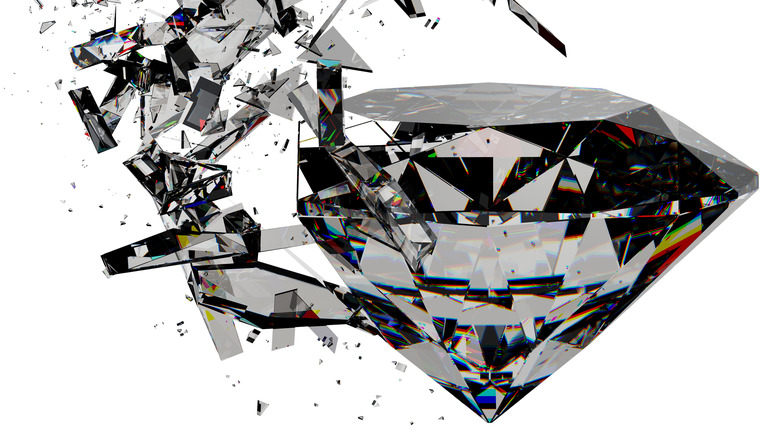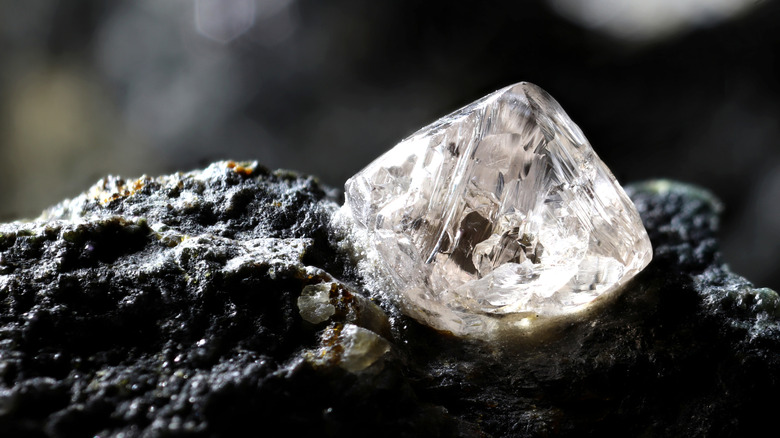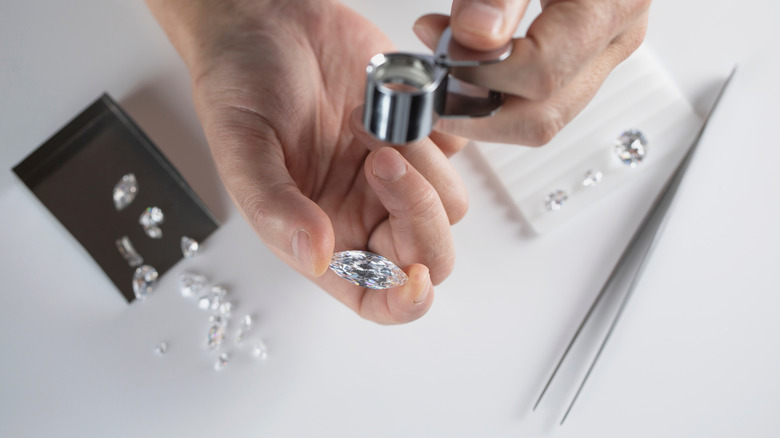Well Actually, Diamonds Aren't As Tough As You Think
Diamond is the hardest naturally occurring material in the world. In fact, its incredible hardness is reflected in the name itself — the word "diamond" is derived from the Ancient Greek word "adámas," which translates to "invincible" or "unbreakable." However, diamonds are far from unbreakable. Strike a diamond with a steel hammer, and it can shatter into tiny shards quite easily.
So how could diamonds be so hard and yet so brittle at the same time? The confusion arises from the definition of "hardness." According to the Cambridge Dictionary the word "hard" can apply to anything that's "not easy to bend, cut, or break." But in materials science, hardness is far less subjective. Scientists use the concept of hardness to measure how well a material resists permanent, localized deformation. Within that definition, there are three types of hardness: scratch, rebound, and indentation.
The scratch hardness of a material is tested by dragging a harder material across the surface and measuring how deep the resulting groove is. The rebound hardness of a material is tested by dropping a hammer-like striking tool tipped with a harder material and measuring how high it bounces. The indentation hardness of a material is tested by pressing it with a harder material at a fixed force and measuring how deep the indentation is. But diamonds have no harder material with which to test them — they'll always deform the tool before the tool can deform them. In fact, diamonds are so hard that they're often used as the maximum standard for calibrating hardness scales. For example, on the Mohs hardness scale, diamonds have the maximum rating of 10. But while diamonds are the hardest of the hard, their chemical structure makes them far from tough.
In scientific terms, diamonds have a low toughness
Just as the word "hard" means something different in materials science and common speech, so too does the word "tough." For most people, the word "tough" is associated with its synonyms durable, hard, or strong. But for a materials scientist, toughness is quite distinct from hardness and strength. Instead, toughness is defined in materials science as, "the amount of force a material can absorb without fracturing." Simply put, hardness measures resistance to changing shape while toughness measures resistance to breaking apart.
Thus, it may come as a surprise to learn that materials scientists consider rubber to be much tougher than a diamond. Among rubber's many interesting properties, it can be pounded with a sledgehammer without fracturing. It might deform with dents and scratches in the process, but the overall structure of rubber requires considerable force to actually break apart. Meanwhile, a diamond will shatter into many tiny pieces on the first smack of a sledgehammer.
Diamond's low toughness is due to its chemical structure. Composed almost entirely of carbon atoms, the molecular structure of a diamond forms a tight crystal lattice. Each atom is covalently bonded to four of its neighbors, resulting in an exceptionally stable structure. Such stability explains why diamonds are hard yet brittle. Scratching a groove into a diamond's surface is nearly impossible, since the carbon atoms are effectively "unwilling" to compromise their stability. This stability fails, however, in the face of a spread-out force that resonates beneath the surface. The quick shock from a hammer blow, for example, ripples through the interior of the diamond. As that shock moves through the structure, weaknesses in the lattice called cleavage planes can split apart, breaking bonds. From there, the diamond falls apart like a house of cards.
How diamonds are (carefully) cut without shattering them
Because diamonds are so hard yet so brittle, cutting them is an extremely delicate business. One wrong move and a diamond can split apart in undesired directions; yet shearing off flat planes isn't as simple as finding a really sharp knife. Diamonds are the hardest naturally occurring material on Earth, so one of the primary tools used to cut them is, naturally, other diamonds.
That's one of the reasons why it's so rare to see a perfectly spherical natural diamond: we don't have hard enough tools to accurately "sand down" the flat edges. Instead, natural diamonds fracture along flat cleavage planes, and diamond cutters use this property to their advantage. They make initial cuts with diamond-tipped saws or lasers, scoring the diamond at the desired angle. Then, a steel cleaver is forced down into the groove to split the diamond into two pieces. Steel is one of the strongest metals on Earth and has a higher toughness than diamond, so it can withstand the force. The split diamond halves are almost molecularly perfect, as the faces of the two halves follow the tetrahedral plane of the diamond's lattice structure. On an atomic level, the covalent bonds between the carbon atoms are severed along the flat plane.
The final steps in diamond cutting also exemplify the material's high hardness and low toughness. To get those iconic faces and sharp angles, cutters once again use diamonds to cut diamonds. During the bruiting phase, diamonds are held in cement bowls with just the undesired edge sticking out. That part is then rubbed against another diamond to wear it down to a flat surface. Once the diamond is shaped, it's polished with a kind of sandpaper made out of — you guessed it — diamond powder.


